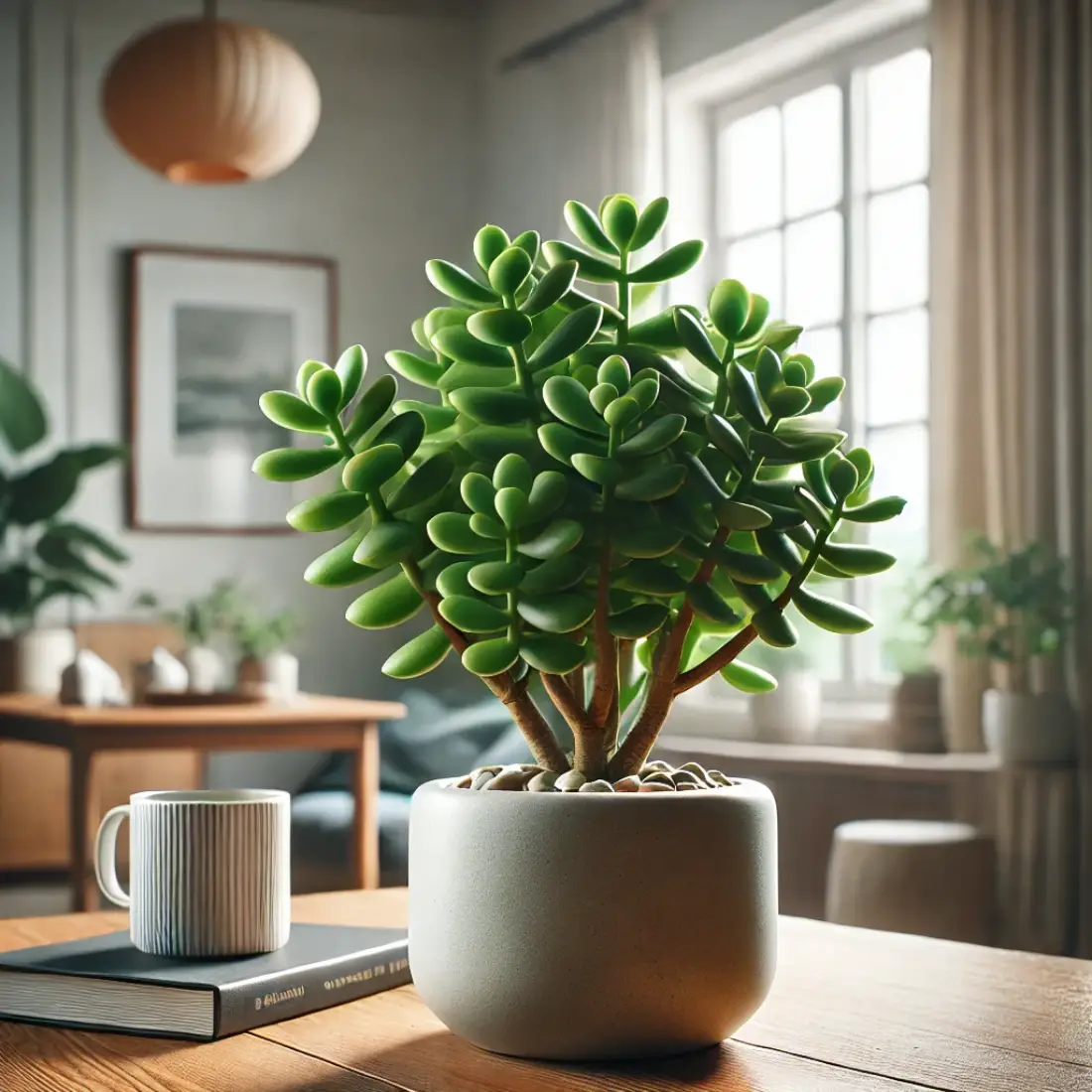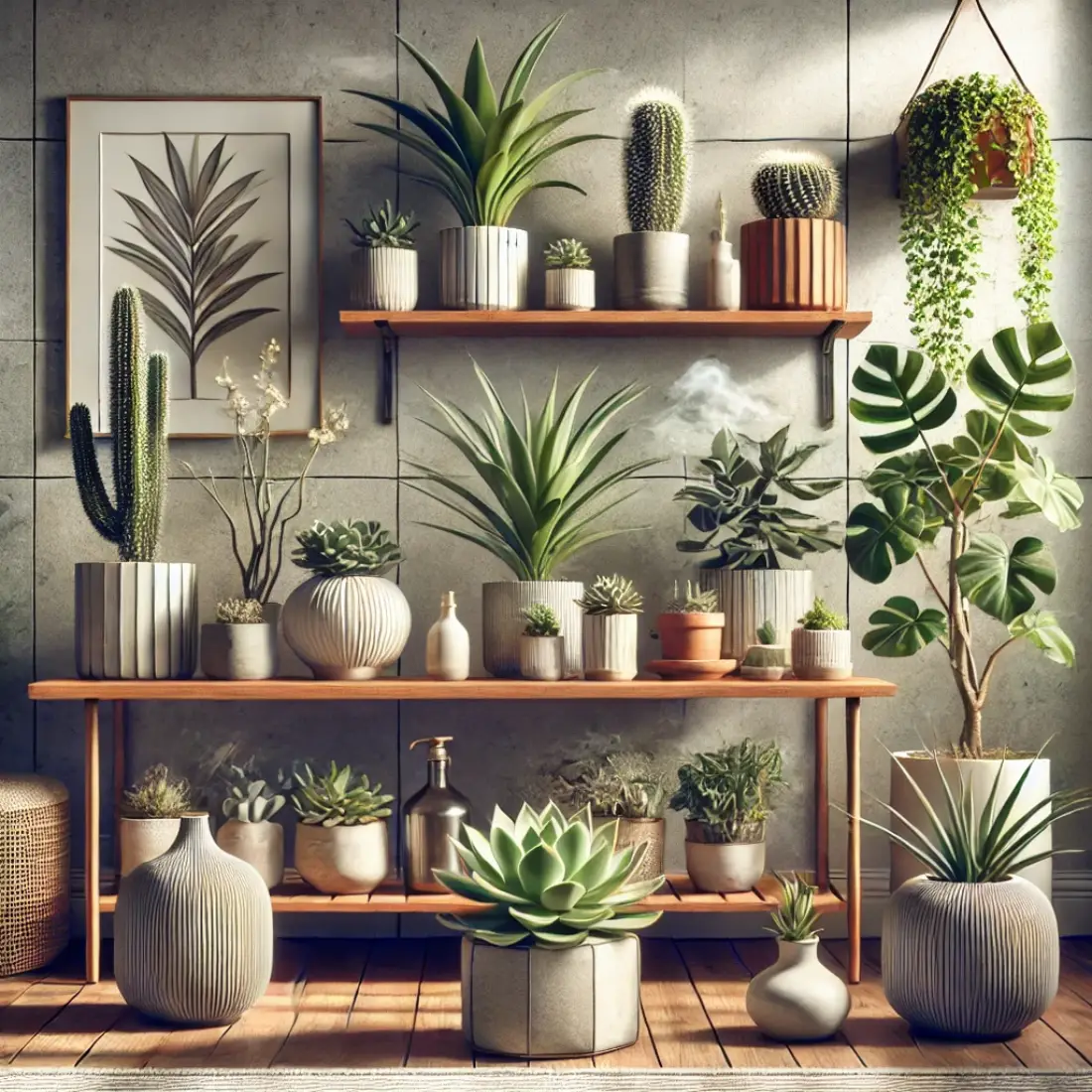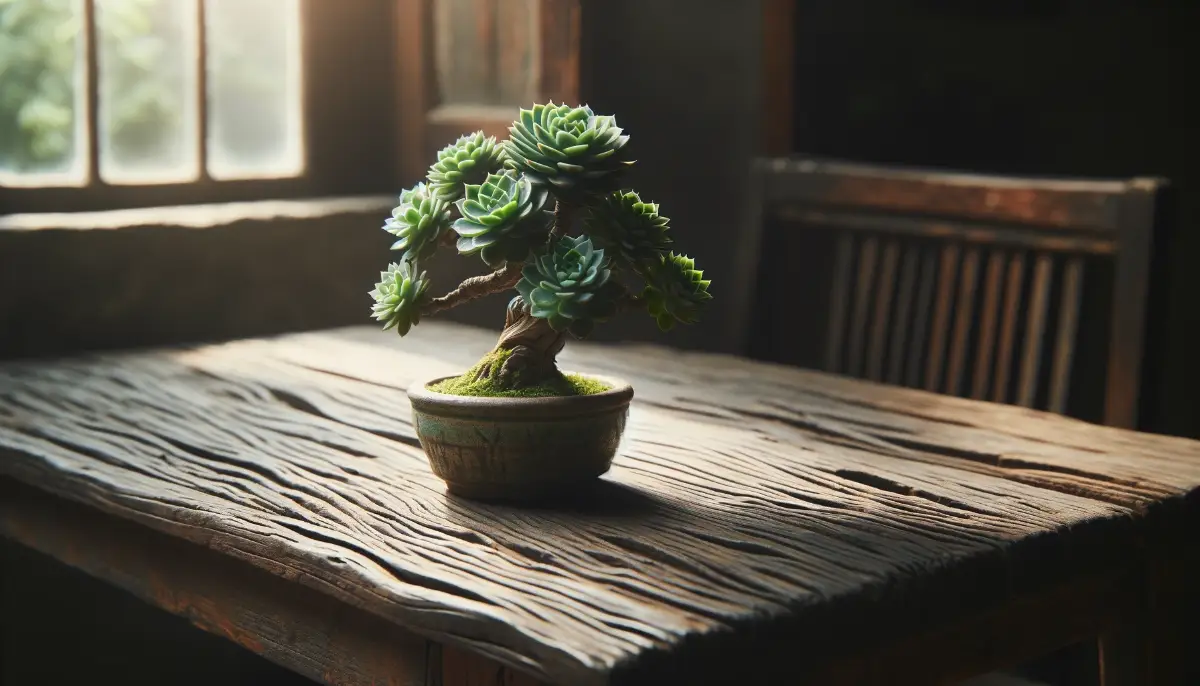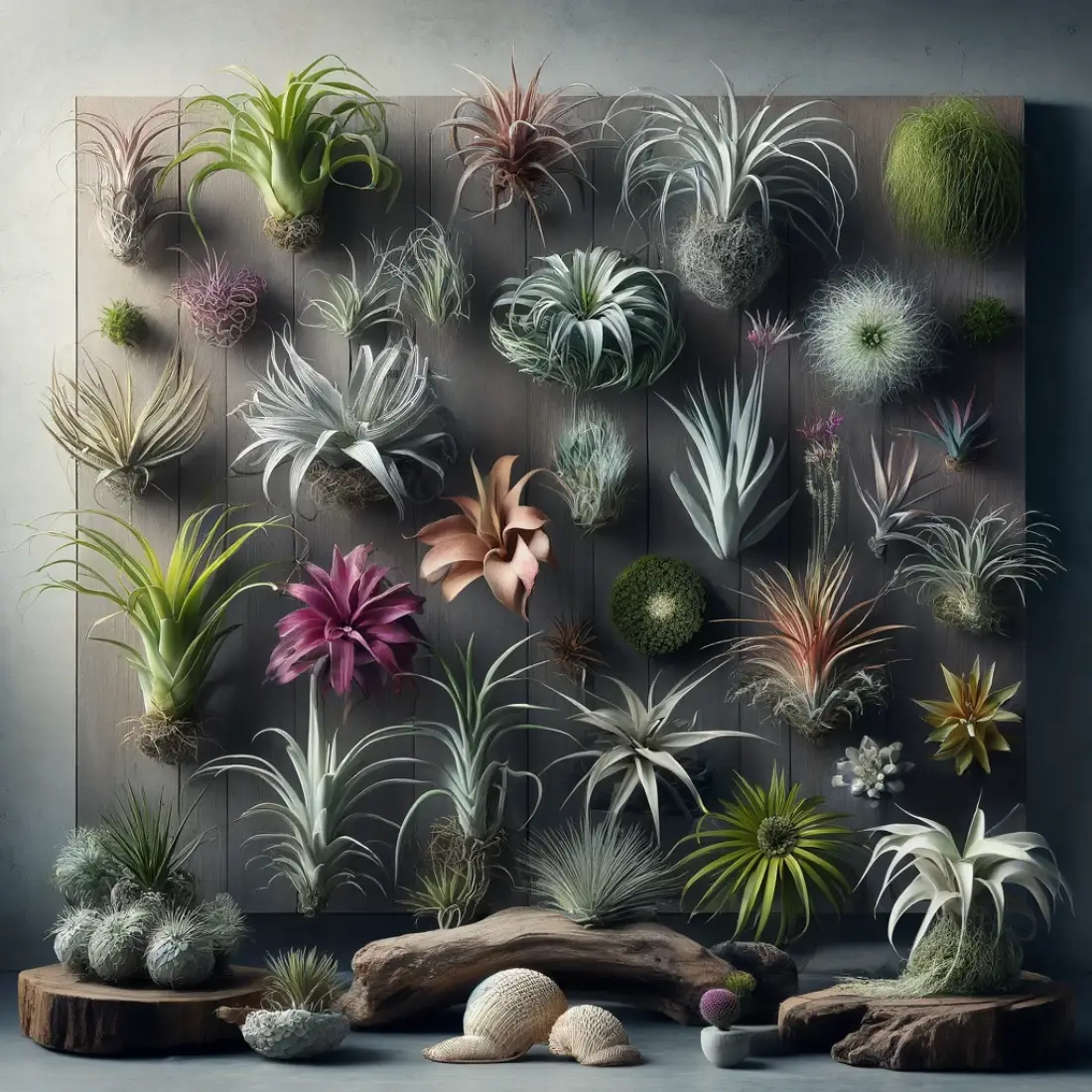Jade plants, also known as Crassula ovata, are beloved for their attractive, fleshy leaves and easy-care nature. These resilient succulents are popular in homes and offices, not just for their beauty but also for the positive energy they are said to bring according to Feng Shui.
- Jade plants are low-maintenance succulents.
- Require well-draining soil and plenty of sunlight.
- Easy to propagate from cuttings.
Types of Jade Plants
Jade plants, known for their fleshy, vibrant leaves and sturdy growth, come in several varieties, each with its own unique charm. Understanding these types can help you choose the best jade plant for your home or office.
Variegated Types
Variegated jade plants add an extra layer of visual interest with their multi-colored leaves. These varieties feature leaves with white, cream, or yellow stripes or spots, creating a striking contrast against the green foliage.
Crassula ovata ‘Variegata’: This variegated variety is particularly popular for its beautiful cream and green striped leaves. It maintains the same hardy and easy-to-care-for nature as the standard jade plant but offers an added aesthetic appeal.
Crassula ovata ‘Hummel’s Sunset’: Known for its vibrant yellow and red-tipped leaves, this variety is perfect for adding a splash of color. The intense hues become more pronounced with ample sunlight, making it a favorite among jade plant enthusiasts.
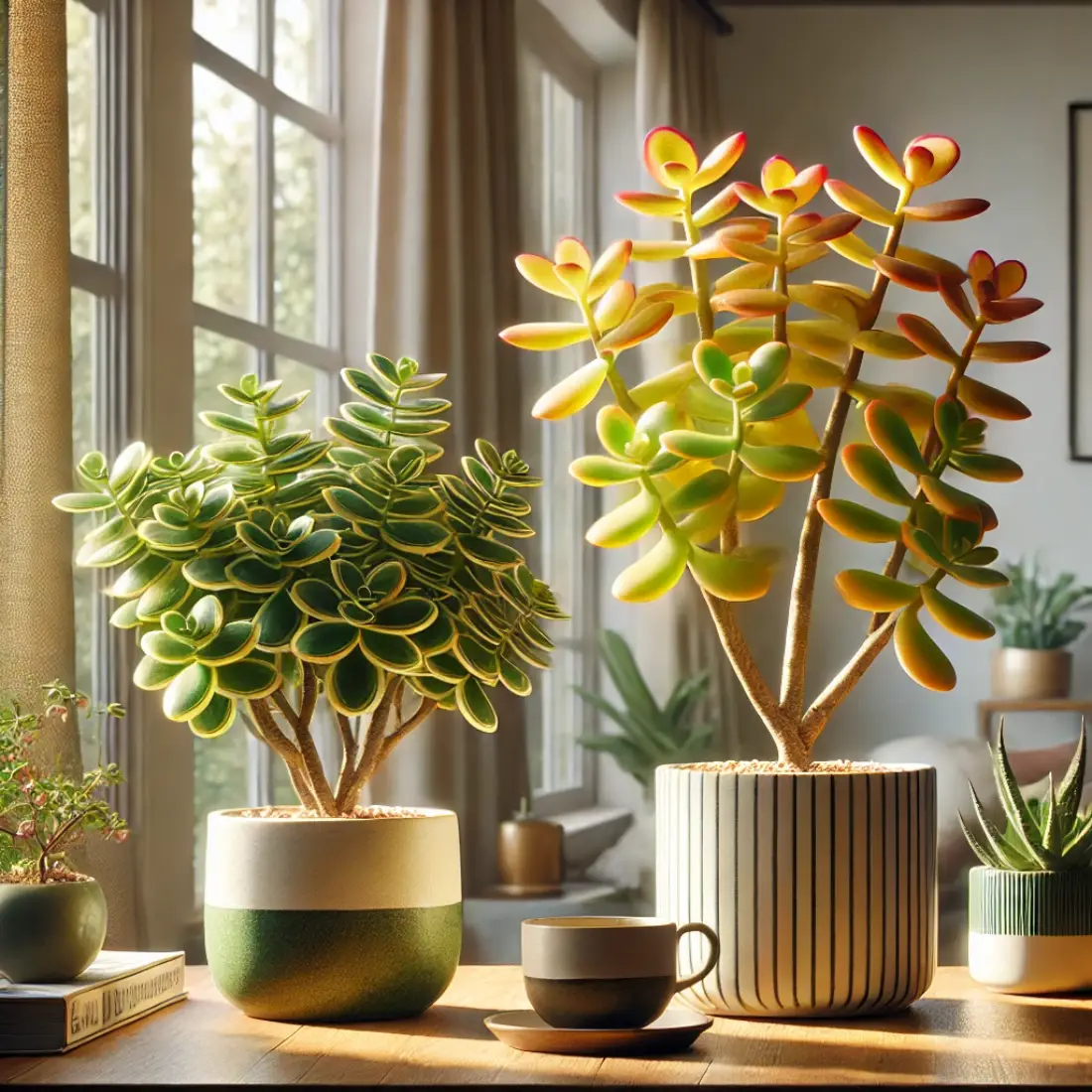
Planting and Potting the Jade Plant
Proper planting and potting are crucial for ensuring your jade plant thrives.
Best Soil for Jade Plants
Jade plants require well-draining soil to prevent root rot and ensure healthy growth. A suitable soil mix is essential for their success.
- Importance of Well-Draining Soil: Jade plants are succulents and store water in their leaves, so they don’t need soil that retains moisture for long periods. Well-draining soil prevents water from pooling around the roots, which can cause rot.
- Recommended Soil Mix: A mix of cactus soil and perlite is ideal. You can also use a regular potting mix with added sand or pumice to improve drainage. Aim for a ratio of about 2:1 for potting mix to sand/perlite.
Choosing the Right Pot
The pot you choose plays a significant role in the health of your jade plant.
- Pot Size and Material: Choose a pot that is slightly larger than the root ball of your jade plant. Terra cotta pots are excellent as they are porous and help the soil dry out between waterings. Plastic pots can also be used but ensure they have good drainage.
- Importance of Drainage Holes: Ensure the pot has drainage holes at the bottom to allow excess water to escape. This is crucial to prevent waterlogging, which can lead to root rot.
Planting Steps
Planting or repotting your jade plant correctly sets the stage for its healthy growth.
- Remove the Plant: Carefully remove the jade plant from its current pot, gently loosening the roots.
- Prepare the Pot: Place a layer of gravel or small stones at the bottom of the new pot to enhance drainage.
- Add Soil: Fill the pot halfway with the well-draining soil mix.
- Position the Plant: Place the jade plant in the center of the pot, spreading the roots out gently.
- Fill with Soil: Add more soil around the plant, pressing it down lightly to remove air pockets. Ensure the base of the plant is at the same level it was in the old pot.
- Water Lightly: Water the plant sparingly to settle the soil, then allow it to dry out before watering again.
- Initial Care After Planting: Place the newly potted jade plant in a location with bright, indirect sunlight. Avoid direct sunlight initially as the plant acclimates to its new environment. Water sparingly, allowing the soil to dry out between waterings.
Watering the Jade Plant
Proper watering is essential for the health and longevity of your jade plant. Understanding how often to water and recognizing the signs of overwatering and underwatering will help keep your plant thriving.
Frequency Based on Seasons
Jade plants are succulents, meaning they store water in their leaves. Their watering needs vary throughout the year, influenced by seasonal changes.
- Spring and Summer: During the growing season (spring and summer), jade plants require more frequent watering. Water the plant thoroughly once every 2-3 weeks, allowing the soil to dry out completely between waterings. The warmer temperatures and increased sunlight cause the plant to use more water.
- Fall and Winter: In the dormant period (fall and winter), reduce watering frequency. Water the plant every 4-6 weeks, as cooler temperatures and lower light levels slow down the plant’s growth and reduce its water needs. Ensure the soil is completely dry before watering again.
Signs of Overwatering and Underwatering
Proper watering techniques are crucial to avoid common issues like root rot from overwatering or dehydration from underwatering.
Signs of Overwatering:
- Yellowing Leaves: One of the first signs of overwatering is yellowing leaves. This occurs when the roots are waterlogged and begin to rot, preventing the plant from absorbing nutrients properly.
- Soft, Mushy Leaves: Overwatered leaves may feel soft and mushy to the touch. This is a sign that the plant is retaining too much water and the cells are bursting.
- Foul Odor: An unpleasant smell from the soil indicates root rot, a direct result of overwatering.
Signs of Underwatering:
- Wrinkled, Shriveled Leaves: Underwatered jade plants will have wrinkled or shriveled leaves as the plant uses up its stored water reserves.
- Leaf Drop: Another sign of underwatering is when the plant starts shedding leaves. This is a survival mechanism to reduce water loss.
- Dry Soil: Consistently dry soil is a clear indicator that the plant is not receiving enough water.
When and How to Fertilize
Fertilizing jade plants ensures they receive essential nutrients for healthy growth. Using organic fertilizers is safe and environmentally friendly.
Types of Fertilizers
- Compost: Provides a balanced mix of nutrients.
- Worm Castings: Rich in nutrients and enhance soil fertility.
- Fish Emulsion: High in nitrogen, promotes leaf growth.
- Bone Meal: High in phosphorus, supports root development.
Spring and Summer: Fertilize once a month during the growing season.
Fall and Winter: Reduce or stop fertilizing during the dormant period.
Dilute liquid fertilizers to half strength to prevent root burn. Water the plant a day before applying fertilizer to ensure even distribution and prevent root burn.
Pruning and Shaping the Jade Plant
Pruning is essential for maintaining the health and appearance of your jade plant. Regular pruning encourages growth, prevents legginess, and helps shape the plant to your desired form.
- Encouraging Growth: Pruning stimulates new growth by redirecting the plant’s energy to healthier branches and leaves.
- Maintaining Shape: Regular trimming helps maintain a compact, aesthetically pleasing shape, preventing the plant from becoming too leggy or top-heavy.
How to Prune a Jade Plant
Pruning your jade plant correctly ensures it stays healthy and continues to grow vigorously.
Best Tools and Techniques:
- Use sharp, sterilized scissors or pruning shears to make clean cuts.
- Disinfect tools with rubbing alcohol before and after use to prevent the spread of disease.
Seasonal Pruning Guide:
- Spring and Summer: The best time to prune is during the growing season when the plant is most active. Trim back overgrown or leggy branches to encourage new growth.
- Fall and Winter: Limit pruning during the dormant period to avoid stressing the plant. Only remove dead or diseased branches.
Step-by-Step Pruning:
- Identify Branches: Look for leggy, overgrown, or damaged branches.
- Make Clean Cuts: Cut just above a leaf node or where the branch meets the stem.
- Shape the Plant: Trim evenly around the plant to maintain a balanced shape.
- Remove Dead Leaves: Regularly remove yellowing or dead leaves to keep the plant healthy.
Methods of Propagation
Propagating jade plants is an easy and rewarding process. You can propagate jade plants through two main methods: leaf cuttings and stem cuttings.
Leaf Cuttings
Leaf cuttings are a straightforward way to propagate jade plants.
- Select a Healthy Leaf: Choose a mature, healthy leaf from the plant.
- Remove the Leaf: Gently twist or cut the leaf from the stem.
- Allow to Callus: Let the leaf sit for a few days to form a callus over the cut end, preventing rot.
- Plant the Leaf: Place the callused end into a well-draining soil mix, and water sparingly.
Stem Cuttings
Stem cuttings tend to root and grow faster than leaf cuttings.
- Select a Healthy Stem: Choose a healthy stem with several leaves.
- Cut the Stem: Use sterilized scissors to cut a 3-4 inch section.
- Allow to Callus: Let the cut end of the stem dry and callus for a few days.
- Plant the Stem: Insert the callused end into a well-draining soil mix, and water lightly.
Propagating jade plants from leaf or stem cuttings involves a few simple steps to ensure successful growth. Whether using leaves or stems, always let the cut ends callus over before planting. This reduces the risk of rot and increases the chances of successful rooting.
Rooting and Planting Cuttings:
Soil Mix: Use a well-draining succulent or cactus mix to plant your cuttings.
Watering: Water sparingly, just enough to keep the soil slightly moist. Overwatering can cause the cuttings to rot.
Light Conditions: Place the cuttings in a bright, indirect light location. Direct sunlight can be too harsh and may dry out the cuttings before they root.
Common Problems and Solutions
Jade plants are generally hardy, but they can encounter problems. Recognizing and addressing these issues promptly ensures your plant remains healthy.
Common Pests
Mealybugs: Small, white, cotton-like pests that cluster on leaves and stems. They can cause leaf drop and stunted growth. Wipe the affected areas with a cotton swab dipped in rubbing alcohol. Repeat as necessary.
Spider Mites: Tiny, red or brown pests that leave webbing on the plant. They cause leaves to yellow and fall off. Spray the plant with a mixture of water and mild soap. Increase humidity around the plant to deter mites.
Common Diseases:
Root Rot: Caused by overwatering, leading to blackened, mushy roots and yellowing leaves. Remove the plant from its pot, cut away affected roots, and repot in fresh, well-draining soil. Water sparingly.
Powdery Mildew: A white, powdery fungus that appears on leaves. Increase air circulation around the plant and treat with a fungicide or a mixture of water and baking soda.
Troubleshooting Issues
Identifying the cause of problems in jade plants can help you take the right corrective actions.
Yellowing Leaves: Overwatering, underwatering, or poor light conditions. Adjust watering schedule, ensuring soil dries out between waterings. Move the plant to a location with appropriate light.
Leaf Drop: Sudden changes in environment, overwatering, or underwatering. Maintain a consistent care routine. Allow soil to dry out between waterings and avoid placing the plant in drafty areas.
FAQs about Jade Plant
How big can a jade plant grow?
Jade plants can grow up to 3-6 feet tall and 2-3 feet wide indoors with proper care. Outdoor plants in ideal conditions can grow even larger.
Can jade plants be grown outdoors?
Yes, jade plants can be grown outdoors in warm climates (USDA zones 10 and 11). They prefer full sun but can tolerate partial shade. Bring them indoors if temperatures drop below 50°F (10°C).
What should I do if my jade plant’s leaves are wrinkled?
Wrinkled leaves indicate the plant is underwatered. Water the plant thoroughly and allow excess water to drain out. Ensure the soil dries out completely between waterings.
How do I revive an overwatered jade plant?
To revive an overwatered jade plant, remove it from its pot and cut away any rotting roots. Repot in fresh, well-draining soil and reduce watering frequency. Allow the soil to dry out between waterings.
Are jade plants toxic to pets?
Yes, jade plants are toxic to cats and dogs if ingested. They can cause vomiting, lethargy, and incoordination. Keep jade plants out of reach of pets.
How can I make my jade plant bloom?
To encourage blooming, provide bright light, cool nighttime temperatures, and reduce watering during the winter. Jade plants typically bloom in winter, producing small white or pink star-shaped flowers.
Why are the leaves of my jade plant turning yellow?
Yellow leaves can result from overwatering, poor drainage, or insufficient light. Adjust your watering schedule, ensure the pot has drainage holes, and place the plant in a brighter location.
How do I propagate a jade plant from a leaf?
To propagate from a leaf, select a healthy leaf and remove it from the plant. Let it callus over for a few days, then place it in well-draining soil. Water sparingly until roots develop.
What type of pot is best for a jade plant?
Terracotta pots are ideal for jade plants as they are porous and allow the soil to dry out between waterings. Ensure the pot has drainage holes to prevent waterlogging.
Can I prune my jade plant at any time of the year?
It’s best to prune jade plants during the growing season (spring and summer). Pruning during this time encourages new growth and allows the plant to recover more quickly. Limit pruning during fall and winter to avoid stressing the plant.

